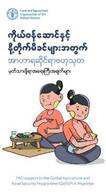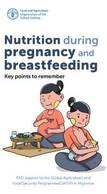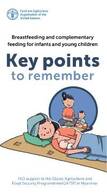VIDEOS
Conserving and sustainably using forests is one of the best ways of protecting our planet and ourselves. Healthy forests are vital for all aspects of a healthy planet, from livelihoods and nutrition to biodiversity and the environment, but they are under threat. Ten million hectares of forest were lost every year to deforestation between 2015 and 2020. Insects damage around 35 million hectares of forest annually, and fire affected approximately 98 million hectares of forest globally in 2015. It’s up to us to safeguard these precious natural resources.
Publications and Documents
ဤစာအုပ်ထုတ်ဝေရခြင်း၏ အဓိကရည်ရွက်ချက်မှာ အမျိုးသမီး (အထူးသဖြင့် ကိုယ်ဝန်ဆောင်နှင့် နို့တိုက်မိခင်များ) နှင့် မွေးစမှ အသက်နှစ်နှစ် အရွယ်ကလေးများ၏ စားသောက်မှုပုံစံများ အာဟာရပိုမို စုံလင်ကောင်းမွန်လာစေရန် ဖြစ်ပါသည်။ ဤစာအုပ်တွင်အမျိုးမျိုးသော အစားအစာတို့ကို လက်တွေ့ကျအသုံးဝင်သော နည်းလမ်းများဖြင့် စိုက်ပျိုးထုတ်လုပ်ခြင်းများ၊ စုဆောင်းခြင်းများ၊ စျေးကွက်အတွင်းပို့ဆောင်ခြင်းများ၊ သိုလှောင်သိမ်းဆည်းခြင်းများ၊ စီမံပြုပြင်ခြင်းများ ပြင်ဆင်ခြင်းများနှင့် စားသုံးခြင်းစသည့်လုပ်ဆောင်ချက်လမ်းညွှန်မှုများပါဝင်ပါသည်။
This handbook is developed to improve the dietary diversity of women (especially during pregnancy and breastfeeding) and children up to the age of two years. It contains practical guidance covering the aspects of production, collection, marketing, storage, processing, preparation, and consumption of diverse foods. Eating a variety of foods in appropriate quantities daily is a key to a healthy diet for everyone. It also encourages the family members to read the handbook and apply the suggested actions for improving the dietary diversity of the family, especially that of women and children.
Food safety is of immense importance and has been a major concern of the consumers, more than its nutritive value and quality. The global trade in food commodities has further necessitated compliance to food safety, hygiene and environmental sustainability. Food commodities produced through climate-smart ways in terms of compliance to good agricultural and environmentally sustainable standards can enhance produce/product competitiveness in the national and international markets. Moreover, food safety is integral to the food and nutrition security of the local population. Capacity building of relevant stakeholders, including GAPs farmers is imperative for the promotion of GAPs at farmers’ field level. The current training manual comprises of two volumes, volume one presents general GAP guidelines for food safety, product quality, environmental management and workers safety, hygiene and welfare in line with Myanmar and ASEAN GAP key criteria and compliance standards, while volume two focuses on target crops specific Good Agriculture Practices (GAPs) at pre and post-harvest stages including processing, packing/packaging. Additional resources on GAPs standards, especially FAO GAP schemes for fruits and vegetables were also consulted with relevant practices included in the manual.
In this curriculum, integrated pest management (IPM) for these selected crops, paddy, groundnut, sesame, green gram and chickpea will be briefly outlined. The general concept of IPM will be the same for these crops although the insect pests, diseases and weeds may differ from one crop to another. The name of pests will be listed for information and important messages those are unique for Myanmar situation will be briefed if necessary, rather than giving detailed account of morphology, biology, ecology and management which can be readily available in published literature. It is aimed to improve the knowledge of farmers on the pests including insects, plant diseases, weeds and rodents causing reduction in the yield of field crops and how to manage the crops to boost the crop production without deteriorating environmental resources for sustainable agriculture.
ဤသင်ရိုးညွှန်းတမ်းတွင် ရွေးချယ်သီးနှံများဖြစ်သော စပါး၊ မြေပဲ၊ နှမ်း၊ ပဲတီစိမ်းနှင့် ကုလားပဲ သီးနှံများ၏ ဘက်စုံပေါင်းစည်းဖျက်ပိုးစီမံခန့်ခွဲခြင်း (IPM) အကြောင်းကို အကျဉ်းချုပ်ဖော်ပြပါမည်။ ဤသီးနှံအားလုံးအတွက် IPM ၏ ယေဘုယျအယူအဆမှာ တူညီသော်လည်း ကျရောက်သော အင်းဆက် ဖျက်ပိုးများ၊ ရောဂါနှင့် ပေါင်းပင်များသည် သီးနှံတစ်ခုနှင့်တစ်ခု ကွဲပြားနိုင်သည်။ ပိုးမွှားများ၏ ရုပ်သွင် ပြင်၊ ဇီဝဗေဒ၊ ဂေဟဗေဒနှင့် စီမံခန့်ခွဲမှုများသည် ပုံနှိပ်ထုတ်ဝေထားသည့် စာပေများတွင် အလွယ်တကူ ရရှိနိုင်သောကြောင့် ၎င်းဖျက်ပိုးများ၏ အမည်ကို သတင်းအချက် အလက်အတွက် စာရင်းပြုစုထားပြီး အရေးကြီး သော သတင်းစကားများကိုသာ လိုအပ်မှုရှိပါက မြန်မာနိုင်ငံ၏ သီးသန့်အခြေအနေကို အကျဉ်းချုပ်ဖော်ပြပါမည်။ အထွက်နှုန်းကျဆင်းမှုကို ဖြစ်စေသည့် အင်းဆက်များ၊ အပင် ရောဂါများ၊ ပေါင်းပင်များနှင့် ကြွက်များအပါအ၀င် ပိုးမွှားများနှင့် ပတ်သက်၍ တောင်သူလယ်သမားများ၏ အသိပညာတိုးတက်စေရန် ရည်ရွယ်ပြီး ရေရှည်တည်တံ့ သော စိုက်ပျိုးရေးလုပ်ငန်းများအတွက် သဘာဝအရင်းအမြစ်များ ယိုယွင်းပျက်စီးခြင်းမရှိဘဲ သီးနှံ ထုတ်လုပ်မှုကို မြှင့်တင်ရန် သီးနှံများကို မည်သို့စီမံ ခန့်ခွဲရမည်ကို သိရှိရန်ရည်ရွယ်သည်။
This curriculum briefly outlines integrated pest management (IPM) for these selected crops, paddy, groundnut, sesame, green gram, and chickpea. The general concept of IPM is the same for these crops, although the insect pests, diseases and weeds differ from one crop to another. The name of pests are listed for information, and important messages that are unique to Myanmar's situation is briefed if necessary, rather than giving a detailed account of morphology, biology, ecology and management, which can be readily available in published literature. It aims to improve farmers' knowledge of the pests, including insects, plant diseases, weeds and rodents causing the reduction in the yield of field crops and how to manage the crops to boost crop production without deteriorating environmental resources for sustainable agriculture.
Handbook on the integrated crop management of rice and paddy for farmer field schools in central dry zone of Myanmar
In this curriculum, integrated pest management (IPM) for paddy will be briefly outlined. The general concept of IPM will be the same for these crops although the insect pests, diseases and weeds may differ from one crop to another. The name of pests will be listed for information and important messages those are unique for Myanmar situation will be briefed if necessary, rather than giving detailed account of morphology, biology, ecology and management which can be readily available in published literature. It is aimed to improve the knowledge of farmers on the pests including insects, plant diseases, weeds and rodents causing reduction in the yield of field crops and how to manage the crops to boost the crop production without deteriorating environmental resources for sustainable agriculture.
ဤသင်ရိုးညွှန်းတမ်းတွင် ရွေးချယ်သီးနှံများဖြစ်သော ပဲတီစိမ်းနှင့် ကုလားပဲ သီးနှံများ၏ ဘက်စုံပေါင်းစည်းဖျက်ပိုးစီမံခန့်ခွဲခြင်း (IPM) အကြောင်းကို အကျဉ်းချုပ်ဖော်ပြပါမည်။ ဤသီးနှံအားလုံးအတွက် IPM ၏ ယေဘုယျအယူအဆမှာ တူညီသော်လည်း ကျရောက်သော အင်းဆက် ဖျက်ပိုးများ၊ ရောဂါနှင့် ပေါင်းပင်များသည် သီးနှံတစ်ခုနှင့်တစ်ခု ကွဲပြားနိုင်သည်။ ပိုးမွှားများ၏ ရုပ်သွင် ပြင်၊ ဇီဝဗေဒ၊ ဂေဟဗေဒနှင့် စီမံခန့်ခွဲမှုများသည် ပုံနှိပ်ထုတ်ဝေထားသည့် စာပေများတွင် အလွယ်တကူ ရရှိနိုင်သောကြောင့် ၎င်းဖျက်ပိုးများ၏ အမည်ကို သတင်းအချက် အလက်အတွက် စာရင်းပြုစုထားပြီး အရေးကြီး သော သတင်းစကားများကိုသာ လိုအပ်မှုရှိပါက မြန်မာနိုင်ငံ၏ သီးသန့်အခြေအနေကို အကျဉ်းချုပ်ဖော်ပြပါမည်။ အထွက်နှုန်းကျဆင်းမှုကို ဖြစ်စေသည့် အင်းဆက်များ၊ အပင် ရောဂါများ၊ ပေါင်းပင်များနှင့် ကြွက်များအပါအ၀င် ပိုးမွှားများနှင့် ပတ်သက်၍ တောင်သူလယ်သမားများ၏ အသိပညာတိုးတက်စေရန် ရည်ရွယ်ပြီး ရေရှည်တည်တံ့ သော စိုက်ပျိုးရေးလုပ်ငန်းများအတွက် သဘာဝအရင်းအမြစ်များ ယိုယွင်းပျက်စီးခြင်းမရှိဘဲ သီးနှံ ထုတ်လုပ်မှုကို မြှင့်တင်ရန် သီးနှံများကို မည်သို့စီမံ ခန့်ခွဲရမည်ကို သိရှိရန်ရည်ရွယ်သည်။
This curriculum briefly outlines integrated pest management (IPM) for these selected crops, green gram, and chickpea. The general concept of IPM is the same for these crops, although the insect pests, diseases and weeds differ from one crop to another. The name of pests are listed for information, and important messages that are unique to Myanmar's situation is briefed if necessary, rather than giving a detailed account of morphology, biology, ecology and management, which can be readily available in published literature. It aims to improve farmers' knowledge of the pests, including insects, plant diseases, weeds and rodents causing the reduction in the yield of field crops and how to manage the crops to boost crop production without deteriorating environmental resources for sustainable agriculture.

This poster is one of the main communication channels to circulate FBDG information out to the public. They are the creative part of FBDG process and includes a combination of core recommendation, sub-messages, visuals as well as written materials that are supported by evidence and written in a way that is easy to understand and apply in daily settings.

Key points
- Humanitarian needs in Myanmar continue to rise sharply since February 2021 as a result of political and economic upheaval and increased conflict.
- Myanmar is facing a rapidly growing food security crisis, with more than 1 in 4 people already food insecure.
- Since January 2022, the Food and Agriculture Organization of the United Nations (FAO) has assisted 17 244 households (85 000 people) through the distribution of agricultural inputs along with the implementation of cash and voucher assistance, enabling them to increase food production and meet their basic needs.
The Myanmar food atlas is a series of photos displaying a variety of foods in standard serving sizes. The photos represent a range of foods customarily consumed by Myanmar people. The food atlas serves as a visual aid with food items in specific quantities or servings for exchange that is useful for meal planning and for fulfilling energy and nutrient requirement as well as special dietary needs of the individuals. Various food composition tables and databases have been referenced and the Myanmar dietary habits have been considered in standardizing the weight and/ or volume of foods for developing this pictorial food guide to aid food portion size estimation. Food items are categorized into six food groups and each food group shares a similar nutrient value(s) of interest. A serving of food can be exchanged with another food serving from the same food group with an aim to promote dietary diversity and fulfill personal food preferences. The Myanmar food atlas is easy to use. It is useful for consumers and health care professionals who have to devise diet plans and menu planning by interchanging foods within the same food group to allow more flexibility for people to follow healthy diets.
The booklet is one of the main communication channels to circulate FBDG information out to the public. They are the creative part of FBDG process and includes a combination of core recommendation, sub-messages, visuals as well as written materials that are supported by evidence and written in way that is easy to understand and apply in daily settings.
The booklet is a simple elaboration of four key recommendation of FBDGs and it is aimed to provide more information and knowledge to community health workers/volunteers and the public who wish to learn more about the core FBDG messages.
In addition, the booklet introduces food exchanges with sample meal plan so that the audience will be able to count their habitual dietary intake to meet recommended dietary allowances and plan nutritionally adequate diets guided by the FBDG recommendations. The booklet also includes the amount of one serving of foods in the 7 food groups and this serving size was defined using common household measures available in Myanmar.
- Key points
- Humanitarian needs in Myanmar continue to rise sharply since February 2021 as a result of political and economic upheaval and increased conflict.
- Myanmar is facing a rapidly growing food security crisis, and nearly one in four people are already food insecure. Ongoing violence, economic crisis, recurrent climate-induced shocks, population displacement and COVID-19, among other factors, are disrupting the entire national food system.
- Since January 2022, the Food and Agriculture Organization of the United Nations (FAO) has assisted 14 115 households (70 575 people) through the provision of staple crop seeds and fertilizers along with the implementation of cash-based interventions, enabling them to produce their own food and meet their basic needs.
Abstract:
Lumpy skin disease virus (LSDV) causes lumpy skin disease in cattle and buffaloes, which is associated with significant animal production and economic losses. Since the 2000s, LSDV has spread from Africa to several countries in the Middle East; Europe; and Asia; including, more recently, several south-east Asian countries. In November 2020, Myanmar reported its first LSD outbreak.
This study reports on the first incursion of LSD in Myanmar and the molecular analysis of the LSDV detected. Staff from the Livestock Breeding and Veterinary Department (LBVD) of the Ministry of Agriculture, Livestock, and Irrigation collected samples from cattle with suspected LSD infection. The Food and Agriculture Organization (FAO) of the United Nations’ emergency Centre for Transboundary Animal Diseases (ECTAD) and the Joint International Atomic Energy Agency (IAEA)/FAO program’s Animal Health and Production laboratory provided LSDV diagnostic support to two regional veterinary diagnostic laboratories in Myanmar. Samples from 13 cattle tested positive by real-time PCR. Selected samples underwent sequence analysis in IAEA laboratories. The results show that the Myanmar LSDV sequences clustered with LSDV isolates from Bangladesh and India, LSDV Kenya, and LSDV NI-2490. Further characterization showed that the Myanmar LSDV is 100% identical to isolates from Bangladesh and India, implying a common source of introduction.
These findings inform diagnosis and development of control strategies.
In 2021, escalating civil unrest further displaced thousands of people in Myanmar, while a third wave of COVID-19 devastated the country. Nearly one in four people are currently experiencing moderate or severe food insecurity. With about three-quarters of the population relying on agriculture for their livelihoods, supporting rural households to restore their production is essential to the humanitarian response. Every USD 1 invested in vegetable production yields more than three times its value in harvests.
This brochure tells the story of how Myanmar is moving away from laws that envision rice-centric land titling and cumbersome land use conversions from rice to other uses. Such laws did not enable farmers to fully engage in this diversification policy, and limits their access to affordable seasonal credit. To spark immediate changes, FIRST supported the Government in implementing a National Land Use Policy that applies free crop choice and gives farmers flexibility to convert and unconditionally title their lands for different uses, such as agroforestry, rice-fish systems and aquaculture. This policy process, which has become more inclusive, is paving the ground for more diverse and nutritious diets.
This document summarizes the highlights and achievements of the Pro-Resilience Action project in Myanmar for the period 2019. The project is one of 10 pro-resilience projects in food crisis contexts implemented within the broader framework of the Partnership Programme supporting the Global Network Against Food Crises (GNAFC). In Myanmar, the aim of the European Union (EU) funded project is to restore and protect agriculture livelihoods of vulnerable communities in Buthidaung, Kyauktaw, Maungdaw, and Rathedaung townships in Rakhine State.
Risk Communication by the State Veterinary Service plays an important role in disease risk mitigation and is an integral part of risk management during animal health emergencies and zoonotic outbreaks. Effective communication recognises its unique functions as complementary to, but unique among, the other non-communication functions required during an emergency or outbreak response, such as, logistics, epidemiology and finances. Communication is uniquely positioned to build knowledge, influence attitudes, raise awareness, build perceptual associations between recommendations and stakeholders’ or audiences’ values, customs, and beliefs.





























